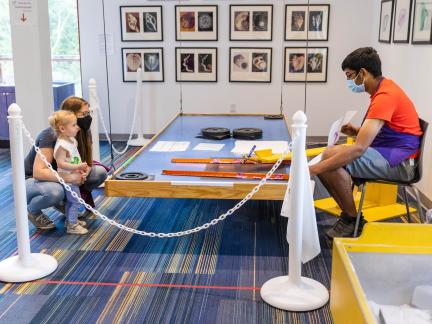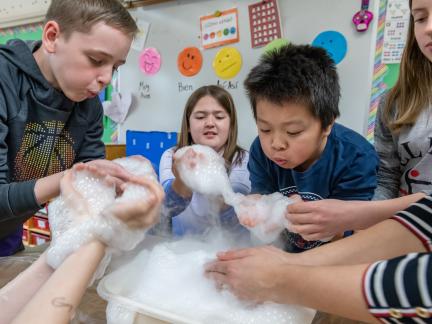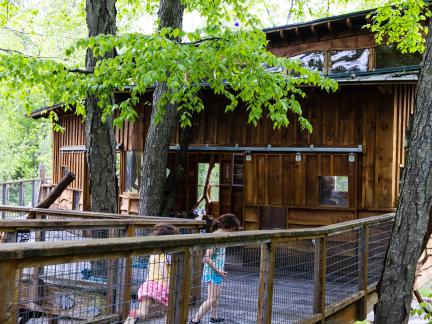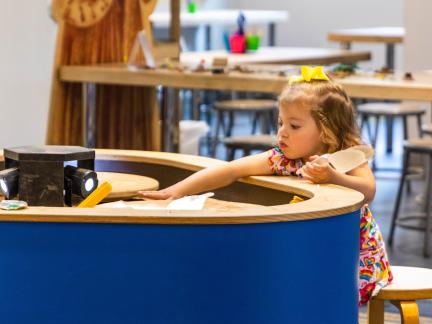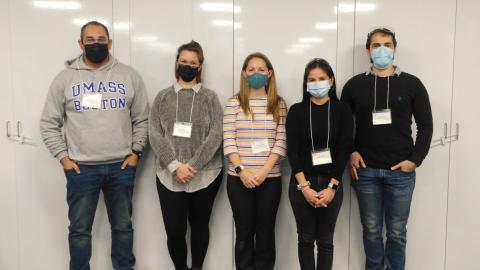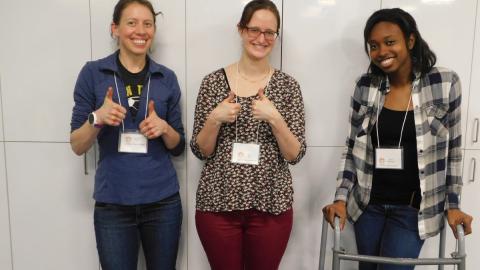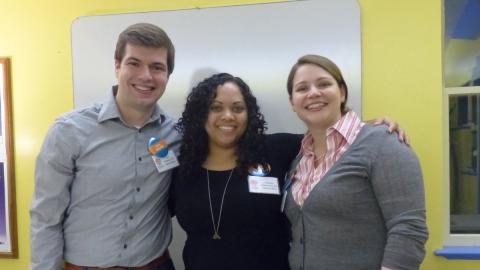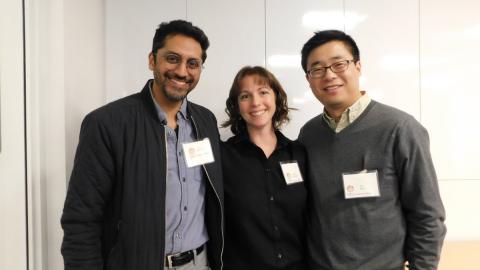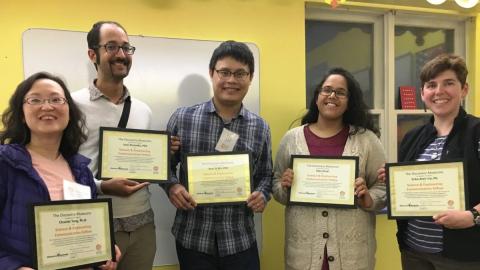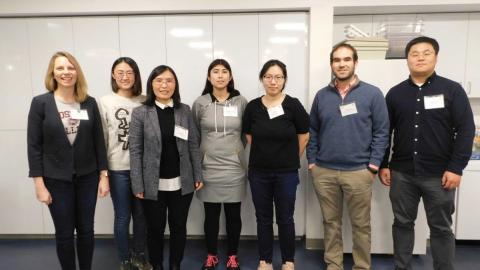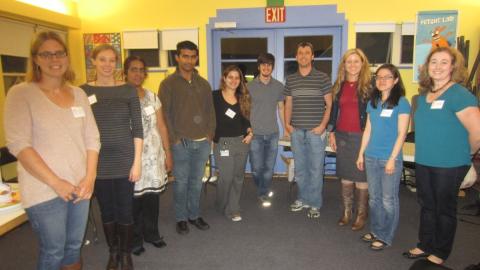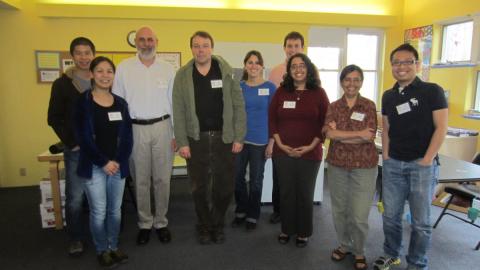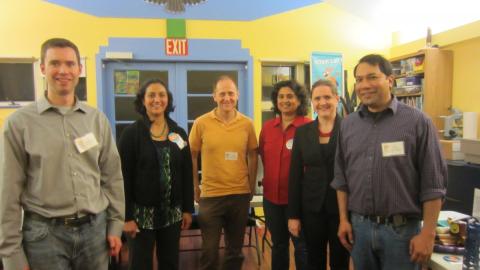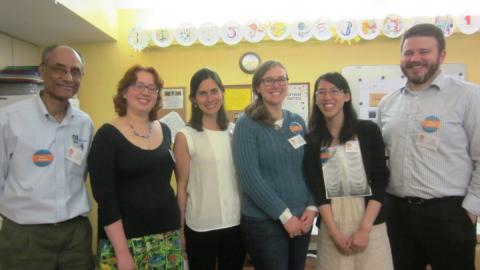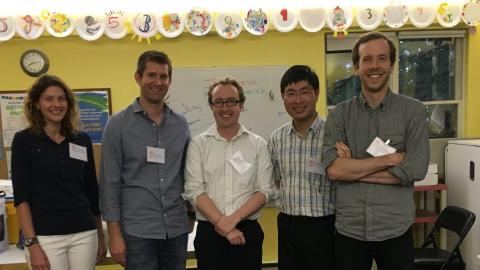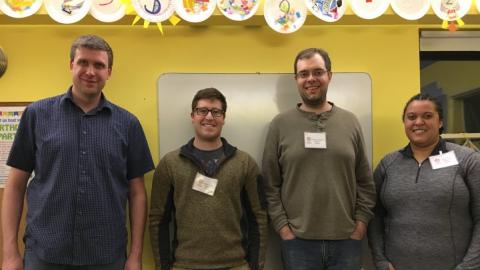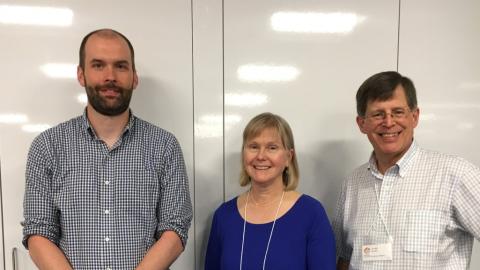Science & Engineering Communication Fellows
Fall 2021
Mohamed Amine Gharbi, Assistant Professor of Physics, University of Massachusetts Boston
Discover the fascinating science behind soft matter. Explore phase changes in liquid crystals, elasticity in squishy toys, and viscosity in slimes.
Jessie Cuomo, Instructor of Biology, Brandeis University
Let's dive in! Discover the unique anatomy of sharks and what makes them perfectly adapted for a life cruising the oceans.
Julianne Gupta, CPO, Prosthetist Orthotist, United Prosthetics Inc
Have you ever wondered how a prosthetic foot works? Discover and learn about the importance of friction in prosthetics by feeling the wide range of materials used to fabricate arms and legs. Then use the electrical signals from your own arm to control a prosthetic hand!
Andrea Mora, Ph.D. Student, and Giorgio Morbioli, Postdoctoral Scholar, Department of Chemistry, Tufts University
Who ate the cookies? Use microfluidics and enzymes to solve a mystery.
Fall 2019
Maureen Ritchey, Ph.D. - Assistant Professor, Boston College
What do you remember about your last birthday? When you remember, different parts of your brain work together to bring back the details. Test the limits of your own memory, draw a memory map, and learn about the parts of the brain that help you think and remember.
Alejandra Gonzalez - Ph.D. student, Brandeis University and Xiang Li - Ph.D. student, Brandeis University
Can you make a paper flower change colors? Find out what happens when paper flowers come into contact with acids and bases!
Xinfang Jin - Assistant Professor, University of Massachusetts Lowell
Explore the inside of Batteries: Can human bodies be electrolytes to form electric circuits? How do you assemble a Lithium-ion coin cell in a glovebox?
Fanglin Che - Assistant Professor, University of Massachusetts Lowell
From Renewable Electricity to Valuable Chemicals and Fuels: Discover how we use computer models to understand the importance of electrode, electrolyte, and pH of electrocatalysis.
Peter Beltramo - Assistant Professor, Department of Chemical Engineering, University of Massachusetts Amherst
Ever wonder how drugs and nutrients get delivered to your cells? Let’s play with soap bubbles and films to find out!
Jianqiang Wei, Ph.D. - Assistant Professor, University of Massachusetts Lowell
If you were to construct a building with concrete blocks, would you always need to include a window? Join us to learn how we can turn drab concrete into something see-through!
Spring 2019
Joanna Dahl, Assistant Professor, University of Massachusetts Boston
Microfluidics, or lab-on-a-chip, is a powerful technology to miniaturize, speed up, and reduce costs of processes and measurements that involve fluids. Try a bioengineering challenge that demonstrates one use of microfluidics: How fast you can make small droplets of all the same size?
Mara Laslo, PhD Candidate, Museum of Comparative Zoology, Harvard University
Learn about what a herpetologist does - we study frogs! Try to spot some frogs yourself, and compare and contrast life cycles of different animals.
Ellice Patterson, Biologist, and Executive Director of Abilities Dance Boston
Let's make spider webs! Using different materials, you will be able to make your own web and see how it would hold up in the real world and learn about spiders in the process.
Fall 2018
Lauren Byrd-Leotis, PhD, Harvard Medical School
Did you know animals get the flu too? Learn about influenza A virus, why certain strains infect birds and not humans, and how we study these virus-host interactions.
Zhu Mao, Assistant Professor, University of Massachusetts Lowell
From Music to Noise: Understanding sound and vibration around us through visualization of vibrational patterns and hands-on experience
Ajay Satpute, PhD, Northeastern University
Fear is a powerful emotion, but what exactly is it made of? To examine the psychology and neuroscience of fear, scientists need to find ways to make people feel afraid and measure their behavioral and brain responses--all in a safe environment! Attendees will create their own unique fear profiles (what makes you afraid?), identify where in their bodies they feel fear (using an emBody tool), experience different varieties of fear, and learn about how the brain creates fear.
Spring 2018
Nancy Knoblock Hunton, MS, Health and Science Writer
Test your knowledge of nutrition. Learn how to build a balanced plate, be sugar smart, and decipher food labels.
Jason Coutermarsh, MathWorks
Learn to program a robot to navigate a maze, using just colored blocks! Explore how light, motors, computer chips and wireless communication work together in this interactive exhibit.
Julie Klaric, PhD Candidate, Brandeis University
Explore the microbial universe! Learn about the various kinds of microbes and the differences between bacteria and viruses.
Dr. Donald E. Hunton, US Air Force Research Laboratory (retired)
How did your smart phone get so smart? Learn how GPS figures out where you are and explore a few ways that the environment can interfere with GPS and make it work less well than it should.
Prof. Maxim Olshanii, University of Massachusetts Boston
Explore a simple homemade simulator that illustrates the principles of Einstein’s Special Relativity.
Rohini Vishwanathan, PhD
Learn about how nutrients found in dark green leafy vegetables, bright yellow fruits and vegetables, avocados and eggs act as natural filters to protect our eyes from damaging blue radiation in sunlight.
Spring 2017
Chunlei Tang, Ph.D., Harvard Medical School
Seeing your life in data! Learn from a data scientist how beautiful data can be, and how data is changing our behavior and lifestyle.
José Alvarado, PhD, Postdoctoral Fellow, Massachusetts Institute of Technology
Feel the effect of flexor- and extensor-muscles on the opening angle of your hand. Open and close your hand. How did your muscles move to do that?”
Dr. Kun-Ta Wu, Postdoctoral Associate/Lecturer, Brandeis University
Have you wondered how water moves through pipes and tubes? Are there new ways to transport fluids without pumps? Learn how scientists have discovered a way, by adding kinesin-driven microtubules, to make water pump itself.
Dipa Desai, AmeriCorps National Teaching Fellow, Citizen Schools
Investigate how paleontology illustrates climate change.
Erika Amir-Lin, PG, AECOM
Did you know that most of the water we drink in Massachusetts comes from under the ground? Experiment with hands-on aquifer models to see how we get water out of the ground and what happens when we take too much out!
Fall 2016
Cara Pina, PhD candidate, Brandeis University
Investigate how bacteria organize their DNA.
Nate Tompkins, PhD, Brandeis University
Explore the synchronization of metronomes, how subtle vibrations can cause two clocks to tick together.
Assistant Professor Matthew Bell, Electrical Engineering Department, University of Massachusetts Boston
Through a modern optical microscope, see what’s inside the computer chips that power the modern electronic devices we use in our everyday lives. Perform a basic fabrication step using tools which scientists and engineers use in microelectronic fabrication foundries all over the world.
Taylor Witkin, Graduate Teaching Assistant and master's student, University of Rhode Island: Marine Affairs Department
Try hands-on activities that demonstrate the impact of overfishing on marine food chains and seafood systems, as well as the differences between selective and non-selective fishing gear.
Spring 2016
Dr. Lindsay Mehrmanesh, Brandeis University
Learn how your sense of taste works. Don’t want to eat your broccoli? You could be a super-taster! Find out what it means and do some taste-tests to see if you have the gene that makes 25% of the population “super-tasters.”
Kene Piasta, PhD, Brandeis University
Explore how antibodies work in your body and learn how scientists utilize them to fight diseases.
Ben Brown-Steiner, PhD, Massachusetts Institute of Technology
Collect data using a physical model of the Earth's atmosphere to learn about the greenhouse effect and the impact of clouds on surface temperatures. Take samples from a collection of one million grains of rice to learn about the concept of a 'part per million' (ppm) and how humans impact the carbon dioxide levels in the atmosphere.
Professor Hsi-Wu Wong, University of Massachusetts Lowell
Learn how you can turn something you usually throw away into something you want!
W. Benjamin Rogers, Assistant Professor, Department of Physics, Brandeis University
Explore how simple ingredients combine to form complex fluids using your hands and optical microscopy.
Fall 2015
Dr. Dan Congreve, MIT
Have you ever wondered how your eye sees colors? Or why LED lighting is so much more efficient than regular light bulbs? Learn how our eyes see different colors, and why that it important for lighting. See how LEDs trick our eyes into thinking every color is present, and why infrared light--the light we cannot see--decreases the efficiency of traditional incandescent light bulbs.
Dr. Shoshoni (Caine) Droz, Northeastern University, College of Science
Why can people pee but birds can't? Come explore how mammals and birds use different kidney systems to reduce water loss during the excretion process.
Dr. Anita Autry, Harvard University
Mind Control: find out how scientists can use molecules to change parental behaviors in animals.
Spring 2015
Prof. Partha Chowdhury of UMass Lowell
Explore the physics of spin!
Rebecca Kreipke, PhD. candidate Brandeis University
Take a turn getting to BE one of the scientists! Explore the scientific method by running a few tests on yourself - and your grown ups! See how your data compares to other visitors.
Dr. Anique Olivier-Mason of Brandeis University and former NYC forensic biologist
Ever wondered what real forensics was really like? Participants use forensic DNA evidence to solve "crimes."
Dr. Cheryl Zurbrick of MIT
Is the ocean dusty? Come investigate how the atmosphere can change oceans from their surface to the very bottom.
Jessica Liu, Ph.D. of Harvard University
Come see how doctors “see” inside our bodies and try your hand at removing pretend “tumors”.
Chase Gerbig, PhD, Project Engineer, Roux Associates
Explore the science and methods of cleaning up oil spills in the environment, including in open water, in the ground, and on birds.
Fall 2014
Michael Hagan, PhD, Brandeis University
Explore how nature and technology achieve complex structures through the assembly of simple units, with a focus on the formation of viruses. Assemble physical models of viruses and a geodesic dome.
Rohini Vishwanathan, PhD, USDA Jean Mayer Human Nutrition Research Center on Aging, Tufts University
Discover the colorful and significant connection between fall foliage, spinach, eggs and your eyes.
Vanja Dunjko, Res. Assistant Professor, University of Massachusetts, Boston
Participate in interactive demonstrations of wave phenomena with water and light and games to illustrate concepts from quantum mechanics.
Professor Piali Sengupta, Brandeis University
Explore the relationship between genotype, the DNA of organisms, and phenotype, the observable characteristics of organisms, using nematode C. elegans (microscopic worms) and humans (you!).
Sara Paquette, PhD, Alkermes, Inc.
Learn about “good bugs” while exploring the world of beneficial bacteria
Dr. Joe Thakuria of Massachusetts General Hospital and Harvard Medical School
Learn some basic principles of DNA extraction and the structure of the DNA molecule while making a strawberry DNA necklace and more.
Spring 2014
Dr. Boris Lau of the Environmental Engineering Program at UMass Amherst
Mix nanoparticles with seawater and physiological fluids and learn why the sticking of nanoparticles to each other is important for the application and safety of nanomaterials.
Dr. Julia Choi of UMass Amherst, School of Health Sciences
Experience motion-capture technology, and explore how the human brain learns new movements.
Dr. Boris Klebanov of Gentle Knowledge
Do activities exploring densest placements of identical geometric figures in flat containers.
Prof. Maxim Olshanii of University of Massachusetts Boston
Explore the relationships between kaleidoscopes, tilings, Newton's cradles, and experiments with atoms at a billionth of a degree above absolute zero.
Alyssa Wilson, Ph.D. candidate at Harvard University
Explore the ways neurons rearrange themselves as we develop, so that they can help our bodies to perform tasks properly.
Dr. Andrew Magyar of the Center for Nanoscale Systems at Harvard University
Make stained glass and learn how electron microscopes can reveal the nano world that gives them color.
Dr. Parizad Bilimoria from the Conte Center at Harvard University
Explore how different types of neurons in our brains communicate with each other, sending “excitatory” vs. “inhibitory” signals that heighten or dampen the activity levels of other neurons.
Professor Bulbul Chakraborty of Brandeis University
Explore the physics of sand.
Dr. Henry Lee of Boston Children’s Hospital, Harvard Medical School
Explore how our brain activities can be visualized using electroencephalogram (EEG).
Fall 2013
Professor Melissa Kosinski-Collins of Brandeis University
Explore how scientists tag molecules in a cell using fluorescent markers. Participants "search" for hidden items in a cell model.
Dr. Jocelyn LeBlanc from Boston Children's Hospital and Harvard Medical School
Explore how the brain is the most remarkable part of the human body through “tricks” demonstrating the amazing ways the brain can adapt.
Dr. Mathangi Krishnamurthy of Fitchburg State University
See how we can affect the speed/rate of chemical reactions, namely decomposition, by using chemical substances called catalysts.
Dr. Dimitra Pouli of Tufts University
Explore the multifaceted nature of light and how interference phenomena can be used for medical diagnosis.
Dr. Casey Wade of Brandeis University
Explore the relationship between chemistry and electricity.
Laura Proctor of MathWorks
Do numeric sorting of numbers, similar to how a computer might apply an algorithm, or pattern, to finish a task.
Dr. Sarah Sundelacruz of Tufts University
Explore how scientists grow tissues to help our bodies heal.
Suanna Selby Crowley, PhD, RPA of Boston College
Do activities exploring the textures, components, and facts about archaeological soils and sediments and how they help tell the story of ancient sites.
